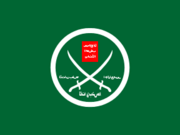
Back የሙስሊም ወንድማማችነት Amharic الإخوان المسلمون Arabic الاخوان المسلمين ARZ Müsəlman Qardaşlar Azerbaijani موسلمان قارداشلار AZB Браты-мусульмане Byelorussian Браты-мусульмане BE-X-OLD Мюсюлманско братство Bulgarian ইখওয়ানুল মুসলিমিন Bengali/Bangla Breudeur vuzulman Breton
Muslim Brotherhood جَمَاعَةُ الَاخْوَانِ الْمُسْلِمِينَ | |
|---|---|
 Muslim Brotherhood logo with the Arabic word for "prepare" present under two crossed swords | |
| Leader | Mohammed Badie |
| Spokesperson | Gehad El-Haddad |
| Founder | Hassan al-Banna |
| Founded | 22 March 1928 Ismailia, Kingdom of Egypt |
| Headquarters | Cairo, Egypt (historical) Unclear (present) |
| Ideology | Pan-Islamism[1] Sunni Islamism[2] Neo-Sufism[3] Qutbism[4][5] Religious conservatism[6] Salafism[7][8] Anti-imperialism[9][10] Social conservatism[11] Anti-Zionism[12] Anti-communism[13] |
| Political position | Right-wing[14][15] |
| Allies | State allies:
Non-state allies:
|
| Designated as a terrorist group by | Full organisation:
Affiliated militant groups only: |
| Party flag | |
 | |
| Website | |
| www www | |
The Society of the Muslim Brothers (Arabic: جَمَاعَةُ الَاخْوَانِ الْمُسْلِمِينَ Jamāʿat al-Ikhwān al-Muslimīn), better known as the Muslim Brotherhood (الْإِخْوَانُ الْمُسْلِمُونَ al-Ikhwān al-Muslimūn) is a transnational Sunni Islamist organization founded in Egypt by Islamic scholar and schoolteacher Hassan al-Banna in 1928.[28] Al-Banna's teachings spread far beyond Egypt, influencing today various Islamist movements from charitable organizations to political parties.[29]
- ↑ Ghattas, Kim (9 February 2001). "Profile: Egypt's Muslim Brotherhood". BBC.
- ↑ Al Jazeera Staff (18 June 2017). "What is the Muslim Brotherhood?". Al Jazeera.
- ↑ R. Halverson, Jeffrey (2010). Theology and Creed in Sunni Islam. New York: Palgrave Macmillan. pp. 62, 65. ISBN 978-0-230-10279-8.
Neo-Sufism assumed the basis of a secondary Athari tendency that we find in the thought of Hasan al-Banna and the Muslim Brotherhood... Neo-Sufism... was a major influence on the thought of Hasan al-Banna and the development of the Muslim Brotherhood..
- ↑ "Brotherhood Organizational Coups: Qutbism of Thought and Pragmatism of Politics". 30 June 2022.
- ↑ "The Muslim Brotherhood's Ties to Extremists".
- ↑ El-Sherif, Ashraf (21 October 2014). "The Muslim Brotherhood and the Future of Political Islam in Egypt". Carnegie Endowment for International Peace.
- ↑ Sageman, Marc (2004). "Chapter 1: The Origins of the Jihad". Understanding Terror Networks. Philadelphia: University of Pennsylvania Press. pp. 7. ISBN 0-8122-3808-7.
- ↑ Lenz-Raymann, Kathrin (2014). "Chapter 3: Salafi Isalm: Social Transformation and Political Islam". Securitization of Islam: A Vicious Circle: Counter-Terrorism and Freedom of Religion in Central Asia. United Kingdom: Transcript Verlag. p. 80. ISBN 978-3837629040. JSTOR j.ctv1fxgjp.7.
- ↑ Chatterjee, Choi (2018). "10: Islamic Fundamentalism in Critical Perspective". The 20th Century: A Retrospective. New York: Routledge. p. 253. ISBN 978-0-8133-2691-7.
- ↑ K. Gani, Jasmine (21 October 2022). "Anti-colonial connectivity between Islamicate movements in the Middle East and South Asia: the Muslim Brotherhood and Jamati Islam". Post Colonial Studies. 26. Routledge: 55–76. doi:10.1080/13688790.2023.2127660. hdl:10023/26238. S2CID 253068552.
- ↑ Gould, J. J. (30 June 2013). "Rick Perry and the Muslim Brotherhood: Compare and Contrast - Mona Eltahawy on social conservatism in Egypt and the U.S." The Atlantic.
- ↑ Strindberg, Anders; Wärn, Mats (2011), Islamism, Polity, p. 87, ISBN 978-0745640624
- ↑ Johnson, Ian (5 February 2011). "Washington's Secret History with the Muslim Brotherhood". The New York Review of Books.
- ↑ Youssef, Bassem (1 May 2013). "The Muslim Brotherhood's 'right-wing' politics game". Al Arabiya English.
- ↑ Dreyfuss, Robert (11 February 2011). "What Is the Muslim Brotherhood, and Will It Take Over Egypt?". Mother Jones.
- ↑ "Iran and Muslim Brotherhood: A Bizarre Alliance of Two Rival Ideologies".
- ↑ "Why Turkey Chose Qatar". 25 June 2017.
- ↑ Drevon, Haenni, Jerome, Patrick (2021). How Global Jihad Relocalises and Where it Leads: The Case of HTS, the Former AQ Franchise in Syria. I – 50014 San Domenico di Fiesole (FI), Italy: European University Institute. pp. 18, 29–31. ISSN 1028-3625.
{{cite book}}: CS1 maint: location (link) CS1 maint: multiple names: authors list (link) - ↑ Y. Zelin, Aaron (2022). "2: The Development of Political Jihadism". The Age of Political Jihadism: A Study of Hayat Tahrir al-Sham. 1111 19th Street NW, Suite 500, Washington DC 20036, USA: The Washington Institute for Near East Policy. p. 11. ISBN 979-8-9854474-4-6.
{{cite book}}: CS1 maint: location (link) - ↑ "عن بنا | وكالة أنباء البحرين".
- ↑ "Egypt's Muslim Brotherhood declared 'terrorist group'". BBC News. 25 December 2013.
- ↑ "Постановление ГД ФС РФ от 12.02.2003 N 3624-III ГД "О Заявлении Государственной Думы Федерального Собрания Российской Федерации "О пресечении деятельности террористических организаций на территории Российской Федерации"" [Resolution of the State Duma of the Federal Assembly of the Russian Federation of February 12, 2003 N 3624-III of the State Duma "On the Statement of the State Duma of the Federal Assembly of the Russian Federation "On the suppression of the activities of terrorist organizations on the territory of the Russian Federation"] (in Russian). Archived from the original on 9 August 2011.
- ↑ "Saudi Arabia declares Muslim Brotherhood 'terrorist group'". BBC News. 7 March 2014.
- ↑ "Assad says 'factors not in place' for Syria peace talks - World News". 22 October 2013.
- ↑ "U.A.E. Supports Saudi Arabia Against Qatar-Backed Brotherhood". Bloomberg.com. 9 March 2014.
- ↑ GARRAUD, Jean-Paul. "Question parlementaire | La confrérie des Frères musulmans officiellement classée comme organisation terroriste | E-003684/2021 | Parlement européen". www.europarl.europa.eu (in French). Retrieved 2024-09-14.
- ↑ "Muslim Brotherhood Gangs (Egypt)". Pro-Government Militia. Retrieved 8 April 2023.
- ↑ Kevin Borgeson; Robin Valeri (9 July 2009). Terrorism in America. Jones and Bartlett Learning. p. 23. ISBN 978-0-7637-5524-9. Retrieved 9 December 2012.
- ↑ "Is the Muslim Brotherhood a Terrorist Group?". The New York Times. 30 April 2019. Retrieved 15 May 2019.